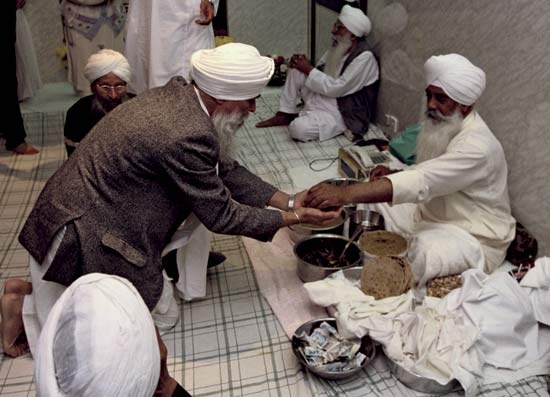gurdwara
Sikh temple
Punjabi“doorway to the Guru”
 the place of worship of the Sikhs (Sikhism), a religious group of India. The gurdwara contains—on a cot under a canopy—a copy of the Adi Granth (Ādi Granth) (“First Volume”), the sacred scripture of Sikhism. It also serves as a meeting place for conducting business of the congregation and wedding and initiation ceremonies. The more historically important gurdwaras serve as centres of pilgrimage during festivals. A communal refectory (langar), in which meals are prepared and served to the congregation, and frequently a school are attached to the gurdwara. Every Sikh family endeavours to set aside one room of the house for the reading of the Adi Granth, and this room is also called a gurdwara.
the place of worship of the Sikhs (Sikhism), a religious group of India. The gurdwara contains—on a cot under a canopy—a copy of the Adi Granth (Ādi Granth) (“First Volume”), the sacred scripture of Sikhism. It also serves as a meeting place for conducting business of the congregation and wedding and initiation ceremonies. The more historically important gurdwaras serve as centres of pilgrimage during festivals. A communal refectory (langar), in which meals are prepared and served to the congregation, and frequently a school are attached to the gurdwara. Every Sikh family endeavours to set aside one room of the house for the reading of the Adi Granth, and this room is also called a gurdwara.The key area of a gurdwara is a spacious room housing the Sri Guru Granth Sahib (“The Granth as the Guru”; also known as the Adi Granth). The community gathers here to participate in devotional activity that typically includes recitation (path) of scripture, singing of scripture to musical accompaniment (kirtan), and its exegesis (katha). Toward the closing of the devotional session, a supplication (ardas) is made in which the Sikhs remember their history, seek divine blessings in dealing with their current problems, and reaffirm their vision of establishing a state in which Sikhs shall rule (Khalsa Raj). The service ends with a hymn read from the Sri Guru Granth Sahib, which is interpreted to be the divine reply (hukam) to the congregation's supplication. Having paid respects to the Sri Guru Granth Sahib and participated in ritual glorification of God, they then discuss day-to-day problems facing the community.
The gurdwaras associated with the Sikh Gurus' lives or their activities serve as centres for Sikh pilgrimage. The leading gurdwaras among these are the Harimandir, or Golden Temple, in Amritsar; the five Takhts located in Amritsar, Anandpur, Damdama, Patna, and Nanded; and the birthplace of Nanak (Nānak), the first Guru and founder of Sikhism, at Nankana, now in Pakistan.
During the period of persecution of the Sikhs by the Mughal Dynasty, the management of some gurdwaras (and the considerable lands and funds attached to them) passed into the hands of Hindu caretakers (mahants). After years of increasing agitation on the part of the Sikhs, the British government passed the Sikh Gurdwara Act in 1925, returning control of the gurdwaras to the Sikhs. The gurdwaras of historic importance are now managed by an elected body known as the Shiromani Gurdwara Prabandhak Committee (“Committee of Shrine Management”).
- Maria Tallchief
- Maria Theresa
- Maria Theresa Kemble
- Maria Walewska
- Maria Weston Chapman
- Mariazell
- Maribo
- Maribor
- Marichal, Juan Antonio
- Marie Adelaide Lowndes
- Marie-Amélie de Bourbon
- Marie-Anne de la Trémoille, princesse des Ursins
- Marie-Anne de la Trémoille Ursins, princesse des
- Marie-Anne de Mailly-Nesle Châteauroux, Duchess de
- Marie-Anne de Mailly-Nesle, Duchess de Châteauroux
- Marie-Antoine Carême
- Marie-Antoinette
- Marie, Baroness (Freifrau) von Ebner-Eschenbach
- Marie Bashkirtseff
- Marieberg pottery
- Marie Bregendahl
- Marie Byrd Land
- Marie Camargo
- Marie-Caroline de Bourbon-Sicile Berry, duchesse de
- Marie-Caroline de Bourbon-Sicile, duchesse de Berry